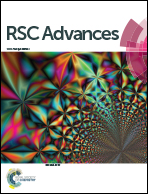An in-depth kinetics study of chemically modified human serum albumin aggregation and fibrillation†
Abstract
It has been firmly established that amyloid aggregates formed by protein misfolding are the main cause of many neurodegenerative diseases. Human serum albumin (HSA) has been studied for a long time as a model for protein aggregation, and it has been shown to have no nucleation step. Herein, chemically modified HSAs with different surface charges are used to study the process of protein fibrillation and the inhibition mechanism of quantum dots (QDs) in aqueous solutions in vitro. This study shows that HSAs with different surface charges have a similar secondary structure, but they show very different thermal stabilities and fibrillation rates. For the first time, using kinetic methods from CD results, we propose that there exists an inflection point which divides the fibrillation process into two stages, an aggregation stage and a fibril formation stage. It is interesting that the inhibitory effect of CdTe QDs mainly affects the first stage of fibrillation rather than the final stage. When incubated with more cationic HSA (cHSA), the cHSA stays in the small cluster stage longer than compared with cHSA without CdTe QDs. Although the HSAs with different surface charge distributions formed fibrils at different rates, they exhibit the same kinetic process. This can give some insights into the design of better inhibitory materials for protein fibrillation, and give us a better understanding about the mechanism of the protein fibrillation process from a physical chemistry perspective.


 Please wait while we load your content...
Please wait while we load your content...